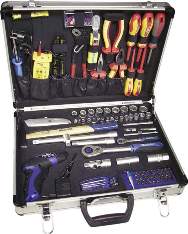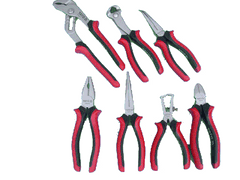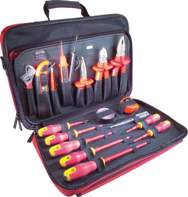Categories: Featured Articles » About electricians and not only
Number of views: 48285
Comments on the article: 1
Electrician tool
 An electrician without power tools, this is not an electrician. After all, whatever your knowledge would be, without the appropriate tools it is impossible to strip the wire, tighten the contact, measure electrical parameters, etc. This is what every electrician should have his own and with him, as they say without a tool as without hands.
An electrician without power tools, this is not an electrician. After all, whatever your knowledge would be, without the appropriate tools it is impossible to strip the wire, tighten the contact, measure electrical parameters, etc. This is what every electrician should have his own and with him, as they say without a tool as without hands.
There is a huge amount of all kinds of tools, both for a specific purpose and all kinds of species.
Perhaps I think that you completely agree with me that having in your house a lot of any various things, you usually have to use only a small part of them, namely the most necessary. So in an electrician, you can carry many tools in a bag, although in practice only some of them are constantly used. That's what it is electrician tool, basic set.
Further, it will be obvious that, depending on the type of work performed, the basic tools of an electrician can also vary. For example, when installing wiring in a house, as a rule, the main ones are used side cutters, tape measure, knife, puncher, drill, grinder, but when repairing, you have to use various measuring devices more often, soldering iron, test items, etc. But in all cases, you definitely can’t do without such a tool:
Side cutters, they are needed always and everywhere. Snack the cable, dissolve the insulation or strip the wire, trim the edges of the plastic box or make a hole by biting them a little. Side cutters in this case are simply not replaceable, although again, who is used to what. Some use nippers, while others serve pliers and a knife. But in any case, side cutters are needed.
 Pliers or pliers, and again I repeat, who is already used to what, many of my familiar electricians, and I myself prefer to use pliers, because they can do everything with pliers, but even a little more.
Pliers or pliers, and again I repeat, who is already used to what, many of my familiar electricians, and I myself prefer to use pliers, because they can do everything with pliers, but even a little more.
For example, very often there is a need to pull out wires with an inconvenient location or from hard to reach places. To do this with pliers is difficult, but with pliers it is much more convenient and safer.
There are many examples from practice, and you yourself have probably come across this. Pliers, of course, are also needed, and you can not do without them.
Dielectric knifeThis is a very necessary and very useful tool. Although not in all cases it is possible for them to dissolve the cable, since it is easy to damage the inner insulation of the core, but with careful use of the knife, they can truly work wonders. He constantly helps out in cases of stripping, cutting, making a hole in a small hole, scraping, poking, etc.
By the way, I advise you to make yourself a rape knife, this steel is very strong and in some cases with such a knife you can even chamfer soft metal.
See also: about the knife of a real electrician.
 Set of screwdrivers, my advice is to have such a set of screwdrivers: a large one with a long working part of about 15cm. rod diameter of about 8mm. and blade width 10mm-12mm. It will be for you in case of large wood screws or an urgent need for some pocket pin.
Set of screwdrivers, my advice is to have such a set of screwdrivers: a large one with a long working part of about 15cm. rod diameter of about 8mm. and blade width 10mm-12mm. It will be for you in case of large wood screws or an urgent need for some pocket pin.
Next, an average screwdriver with a blade width of 6-8mm, slightly smaller with a 4-5mm blade, and a small one with a 2-3mm blade. It does not hurt to have a couple of medium-sized Phillips screwdrivers with you, well, a small set of clock or mini-screwdrivers, for the case of repair of specific electronic and electrical devices that come across from time to time.
 Electronic tester, perhaps for the simplest work, the most usual will go with a set of ordinary functions, such as measuring AC and DC current and voltage, resistance, as well as an audible sound in the form of a tweeter (very often you have to use it), well, it would be better to take a tester with current clamps.
Electronic tester, perhaps for the simplest work, the most usual will go with a set of ordinary functions, such as measuring AC and DC current and voltage, resistance, as well as an audible sound in the form of a tweeter (very often you have to use it), well, it would be better to take a tester with current clamps.
It does not cost much more, and has all the same functions, but will be of great benefit in repairing and checking the value of alternating current, without disconnecting the contact. He helps out a lot when checking the operation of an asynchronous electric motor, when it is easy to detect the inequality of currents on its windings during operation.
Phase indicatorEvery electrician must have it. And this is not subject to discussion.
Well, it would also be nice to keep in your bag: electrical tape, cotton and rubber gloves, a flashlight, an insulated brush, tweezers, a soldering iron, solder, rosin, a lighter, an awl, a set of wrenches up to size 19 or a small adjustable wrench, a set of hexagons , a couple of files.
See also at i.electricianexp.com
:
